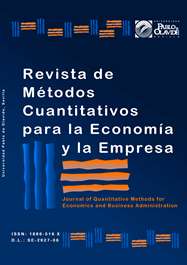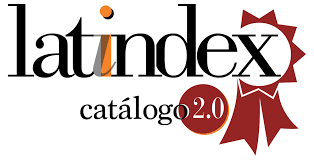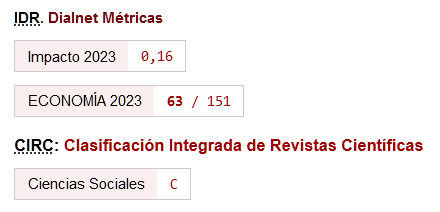Influence of Open Innovation, Strategic Flexibility, and Corporate Risk Management on Competitive Advantage.
Analysis in the Portuguese Hotel Sector
DOI:
https://doi.org/10.46661/rev.metodoscuant.econ.empresa.7340Keywords:
inbound open innovation, outbound open innovation, competitive advantage, hotel industry, quantile regression, partial least squaresAbstract
This paper analyses the effects of open innovation (OI), organizational strategy and the existence of a corporate risk management (CRM) strategy on competitive advantage (CA) in cost, service and product in the Portuguese hotel sector. This paper uses a survey over 251 CEOs of Portuguese small and medium-sized enterprises (SMEs) hotels and applies two complementary statistical methods: partial least squares regression and quantile regression. It can be stated that both OI and the degree of dynamism and flexibility of the organizational structure and CRM are relevant to explain the different types of competitive advantage. However, the results show that the importance of the incidence of the different explanatory factors considered is different depending on the type of competitive advantage that we are analysing and the relevance of disaggregating those associated with AI (inbound and outbound) and organizational strategy (dynamic of the environment, internal organizational flexibility and innovative strategic position). Thus, the CRM variable is the fundamental variable in the explanation of the competitive advantage in cost, while the incidence of inbound OI is especially relevant in the CA in service and product. Within organizational strategy, the factor that most clearly affects competitive advantage is the strategic position with respect to innovation.
Downloads
References
Abhari, K. & McGuckin, K. (2022). Limiting factors of open innovation organizations: A case of social product development and research agenda. Technovation, 102526, https://doi.org/10.1016/j.technovation.2022.102526.
Barmuta, K. A., Akhmetshin, E. M., Andryushchenko, I. Y., Tagibova, A. A., Meshkova, G. V. & Zekiy, A. O. (2020). Problems of business processes transformation in the context of building digital economy. Entrepreneurship and Sustainability Issues, 8(1), 945 http://doi.org/10.9770/jesi.2020.8.1(63)
Bril, A., Kalinina, O., Valebnikova, O., Valebnikova, N., Camastral, M., Shustov, D. O. & Trovskaya, N. (2021). Improving Personnel Management by Organizational Projects: Implications for Open Innovation. Journal Open Innovation Technology, 7(105), 1-16. https://doi.org/10.3390/joitmc7020105.
Brozovic, D. (2018). Strategic flexibility: A review of the literature. International Journal of Management Reviews, 20(1), 3-31. https://doi.org/10.1111/ijmr.12111.
Chaudhary, S., Kaur, P., Talwar, S., Islam, N. & Dhir, A. (2022). Way off the mark? Open innovation failures: Decoding what really matters to chart the future course of action. Journal of Business Research, 142, 1010-1025. https://doi.org/10.1016/j.jbusres.2021.12.062.
Cheng, C.C.J. & Huizingh, E.K.R.E. (2014). When Is Open Innovation Beneficial? The Role of Strategic Orientation. Journal of Product Innovation Management, 31(6), 1235–1253. https://doi.org/10.1111/jpim.12148.
Chesbrough, H. & Bogers, M. (2014). Clarifying an emerging paradigm for understanding innovation. En H. Chesbrough, W. Vanhaverbeke & J. West (Eds.), New Frontiers in Open Innovation (pp. 3-28). Oxford University Press.
https://doi.org/10.1093/acprof:oso/9780199682461.001.0001
Chiaroni. D., Chiesa. V. & Frattini F. (2011). The Open Innovation Journey: How Firms Dynamically Implement the Emerging Innovation Management Paradigm. Technovation, 31(1), 34-43. https://doi.org/10.1016/j.technovation.2009.08.007.
Covin, J.G. & Slevin, D.P. (1989). Strategic Management of Small Firms is Hostile and Benign Environments. Journal Strategic of Management, 10(1), 75-87. https://doi.org/10.1108/MBE-07-2013-0042.
Crema, M., Verbano. C. & Venturini, K. (2014). Linking strategy with open innovation and performance in SMEs. Measuring Business Excellence, 18(2), 14-27. https://doi.org/10.1108/MBE-07-2013-0042.
Dahlander, L., Gann, D. M. & Wallin, M. W. (2021). How open is innovation? A retrospective and ideas forward. Research Policy, 50(4), 104218. https://doi.org/10.1016/j.respol.2021.104218
Elahi, E. (2013). Risk management: the next source of competitive advantage. Foresight, 15 (2), 117-131. https://doi.org/10.1108/14636681311321121.
Fedriani Martel, E. M. & Romano Paguillo, I. (2017). Análisis cualitativo comparativo difuso para determinar influencias entre variables socio-económicas y el rendimiento académico de los universitarios. Revista de Métodos Cuantitativos para la Economía y la Empresa, 24, 250-269. https://www.upo.es/revistas/index.php/RevMetCuant/article/view/2889
Fornell, C. & Larcker, D. (1981). Evaluating structural equation models with unobserved variables and measurement error. Journal of Marketing Research, 18(1), 39-50. https://doi.org/10.1177/002224378101800104.
Giannoccaro, I. (2018). Centralized vs. decentralized supply chains: The importance of decision maker’s cognitive ability and resistance to change. Industrial Marketing Management, 73, 59-69. https://doi.org/10.1016/j.indmarman.2018.01.034.
Greco, M., Grimaldi, M. & Cricelli, L. (2015). Open innovation actions and innovation performance: A literature review of European empirical evidence. European Journal of Innovation Management, 18(2), 150–171. https://doi.org/10.1108/EJIM-07-2013- 0074
Hair, J.F., Risher, J.J., Sarstedt, M. & Ringle, C.M. (2019). When to use and how to report the results of PLS-SEM. European Business Review, 31(1), 2-24. https://doi.org/10.1108/EBR-11-2018-0203
Hamelink, M. & Opdenakker, R. (2019). How business model innovation affects firm performance in the energy storage market. Renewable Energy, 131, 120-127. https://doi.org/10.1016/j.renene.2018.07.051.
Hansen, M. T. & Nohria, N. (2004). How to build collaborative advantage. MIT Sloan Management Review, 46(1), 22-30.
Kaleka, A. (2002). Resources and capabilities driving competitive advantage in export markets: guidelines for industrial exporters. Industrial Marketing Management, 31(3), 273-283. https://doi.org/10.1016/S0019-8501(00)00148-6.
Koenker R. & Bassett Jr G. (1978). Regression quantiles. Econometrica, 46(1), 33-50. https://doi.org/10.2307/1913643.
Koenker, R. & Hallock, K. F. (2001). Quantile regression. Journal of Economic Perspectives, 15(4), 143-156. https://doi.org/10.1257/jep.15.4.143.
Lee, J., Minb, J. & Lee, H. (2016). The Effect of Organizational Structure on Open Innovation: A Quadratic Equation. Procedia Computer Science, 91, 492-501. https://doi.org/10.1016/j.procs.2016.07.128.
Lee, S., Park, G. Yoon, J., & Park, J. (2010). Open innovation in SMEs: An intermediated network model. Research Policy, 39, 290–300. https://doi.org/10.1016/j.respol.2009.12.009.
Lichtenthaler, U. (2009). Outbound open innovation and its effect on firm performance: examining environmental influences. R&D Management, 39(4), 317-330. https://doi.org/10.1111/j.1467-9310.2009.00561.x.
Lichtenthaler, U. (2011). Open innovation: Past research, current debates, and future directions. Academy of Management Perspectives, 25(1), 75-93. https://doi.org/10.5465/amp.25.1.75.
Lu, Q. & Chesbrough, H. (2021). Measuring open innovation practices through topic modelling: Revisiting their impact on firm financial performance, Technovation, 114, 102434, https://doi.org/10.1016/j.technovation.2021.102434.
Michelino, F., Caputo, M., Cammarano, A. & Lamberti, E. (2014). Inbound and outbound open innovation: organization and performances. Journal of Technology Management & Innovation, 9(3), 65-82. http://dx.doi.org/10.4067/S0718-27242014000300005.
Moradi, E., Mohammadbagher, S.J., Mohammadi, Z.D. & Mirzaei, A. (2021), Impact of organizational inertia on business model innovation, open innovation and corporate performance. Asia Pacific Management Review, 26(4), 171-179. https://doi.org/10.1016/j.apmrv.2021.01.003.
Morgan, P,M., Jeffrey, G.C. & Michael, B.H. (2000), The Relationship between Environmental Dynamism and Small Firm Structure, Strategy, and Performance. Journal of Marketing Theory and Practice. The Marketing and Entrepreneurship Interface, 8(2), 63-78. https://doi.org/10.1080/10696679.2000.11501869.
Musiello-Neto, F., Rua, O.L., Arias-Oliva, M. & Silva, A.F. (2021). Open Innovation and Competitive Advantage on the Hospitality Sector: The Role of Organizational Strategy. Sustainability, 13(24), 13650. https://doi.org/10.3390/su132413650.
Nayak, B., Bhattacharyya, S. S. & Krishnamoorthy, B. (2022). Exploring the black box of competitive advantage–An integrated bibliometric and chronological literature review approach. Journal of Business Research, 139, 964-982. https://doi.org/10.1016/j.jbusres.2021.10.047.
Nocco, B.W. & Stulz, R.M. (2006). Enterprise risk management: theory and practice. Journal of Applied Corporate Finance, 18(4), 8-20. https://doi.org/10.1111/j.1745-6622.2006.00106.x.
Rua, O.L. França, A., & Fernández, R.O. (2018). Key drivers of SMEs export performance: the mediating effect of competitive advantage. Journal of Knowledge Management, 22(2), 257–270. https://doi.org/10.1108/JKM-07-2017-0267.
Siggelkow, N. & Levinthal, D., A. (2003), Temporarily Divide to Conquer: Centralized, Decentralized, and Reintegrated Organizational Approaches to Exploration and Adaptation. Organization Science, 14(6), 650-669. https://doi.org/10.1287/orsc.14.6.650.24840.
Sisodiya, S.R., Johnson, J.L. & Grégoire, Y. (2013) Inbound open innovation for enhanced performance: Enablers and opportunities. Industrial Marketing Management, 42(5), 836-849. https://doi.org/10.1016/j.indmarman.2013.02.018.
Skordoulis, M., Ntanos., S., Kyriakopoulos, G.L., Arabatzis., G., Galatsidas., S. & Chalikia., M. (2020). Environmental Innovation, Open Innovation Dynamics and Competitive Advantage of Medium and Large-Sized Firms. Journal of Open Innovation: Technology, Market, and Complexity, 6(4), 1-30. https://doi.org/10.3390/joitmc6040195.
Skourtis, G., D´Ecaudin, J. M., Assiouras, I. & Karaosmanoglu, E. (2019). Does the cocreation of service recovery create value for customers? The underlying mechanism of motivation and the role of operant resources. European Management Review, 16(4), 997–1013. https://doi.org/10.1111/emre.12301.
Soriano, J. L. & Mejía-Trejo, J. (2022). Modelado de Ecuaciones Estructurales en el campo de las Ciencias de la Administración. Revista de Métodos Cuantitativos para la Economía y la Empresa, 33, 242-263.
https://doi.org/10.46661/revmetodoscuanteconempresa.5414
Sutanto, E. M. (2017). The influence of organizational learning capability and organizational creativity on organizational innovation of Universities in East Java, Indonesia. Asia Pacific Management Review, 22(3), 128-135. https://doi.org/10.1016/j.apmrv.2016.11.002.
Terán-Bustamante, A., Martínez-Velasco, A. & Dávila-Aragón, G. (2021) Knowledge Management for Open Innovation: Bayesian Networks through Machine Learning. Journal Open Innovation Technology. Market and Complexity, 7(1), 40. https://doi.org/10.3390/joitmc7010040.
Parodi, C. (2018). La gran desaceleración económica mundial 2011-2015 (Documento de discusión No. 1804). Universidad del Pacífico. http://repositorio.up.edu.pe/handle/11354/2060
Vicéns-Otero, J.V. & Sánchez-Reyes, B. (2012). Regresión Cuantílica: estimación y contrastes (Documento de Trabajo No. 21). Instituto LR Klein-Centro Gauss. https://www.uam.es/uam/media/doc/1606862082401/regresion-cuantilica-estimacion-y-contrastes.pdf.
Wong, E.M., Ormiston, M.E. & Tetlock, P.E. (2011). The effects of top management team integrative complexity and decentralized decision making on corporate social performance. Academy of Management Journal, 54(6), 1207-1228. https://doi.org/10.5465/amj.2008.0762
Yang, Z.J., Lin, J. & Yang, Y., S. (2021), Identification of network behavioral characteristics of high-expertise users in interactive innovation: The case of forum autohome. Asia Pacific Management Review, 26(1), 11-22. https://doi.org/10.1016/j.apmrv.2020.06.002.
Published
How to Cite
Issue
Section
License
Copyright (c) 2023 Jorge de Andres-Sanchez, Eugenio Musiello-Neto, Orlando Lima-Rúa, Mario Arias-Oliva

This work is licensed under a Creative Commons Attribution-ShareAlike 4.0 International License.
Submission of manuscripts implies that the work described has not been published before (except in the form of an abstract or as part of thesis), that it is not under consideration for publication elsewhere and that, in case of acceptance, the authors agree to automatic transfer of the copyright to the Journal for its publication and dissemination. Authors retain the authors' right to use and share the article according to a personal or instutional use or scholarly sharing purposes; in addition, they retain patent, trademark and other intellectual property rights (including research data).
All the articles are published in the Journal under the Creative Commons license CC-BY-SA (Attribution-ShareAlike). It is allowed a commercial use of the work (always including the author attribution) and other derivative works, which must be released under the same license as the original work.
Up to Volume 21, this Journal has been licensing the articles under the Creative Commons license CC-BY-SA 3.0 ES. Starting from Volume 22, the Creative Commons license CC-BY-SA 4.0 is used.










